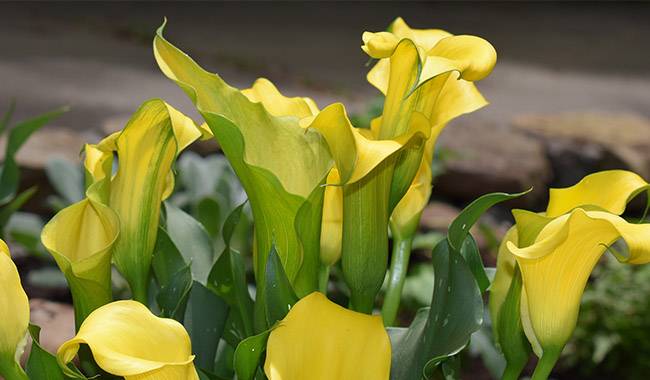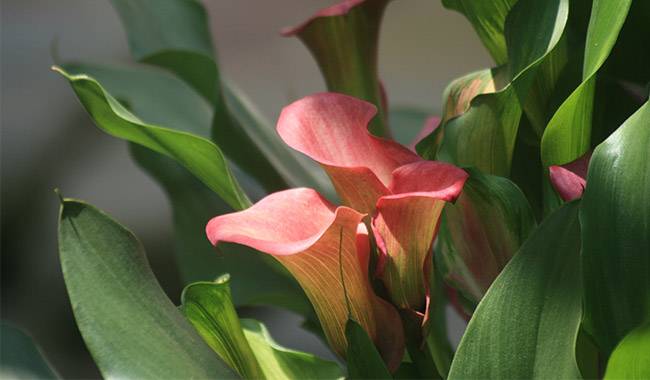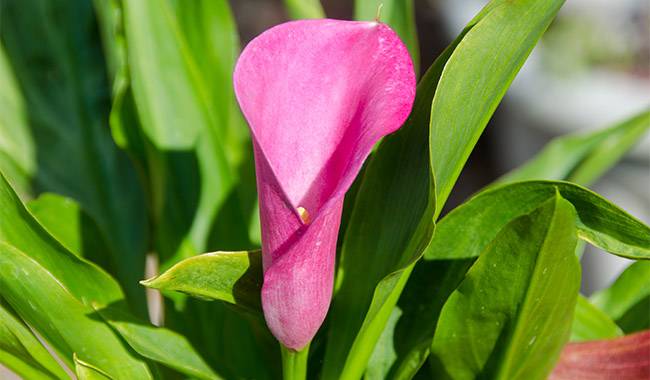
The majestic inflorescence of Calla lily (Zantedeschia) has long been a classic. Their large leaves resemble silk shields and accentuate their beauty. The flowering Calla lily seems to be a luxurious living bouquet in a pot. But their dense and colorful coverings around the inflorescence can easily be misunderstood. After all, Calla lily is only as “sturdy” as it looks. As one of the most capricious houseplants, Calla lily does not like any deviation from its ideal environment. And it has quite a few requirements, even for the simplest of watering. You will learn How to Grow and Care for Calla lily (Zantedeschia) in the ThumbGarden article.
Calla Lily (Zantedeschia) Plant Description
Calla lily is a heat and humidity-loving species, not a common member of the Aroideae. It is one of the best-known beautiful tuberous flowers for indoor use. To this day, the name Calla lily has caused considerable confusion. In the past, the plant was so often transferred from one genus to another that the former names – Calla lilychia, Zantedeschia aethiopica, and even Aroideae – are still popular.
Indoor Calla lily reaches a height of 16-32 inches (40-81 cm). Their roots and leaves are very beautiful. They are large, up to 18 inches (45 cm) long and half as wide, a surprisingly large number for a tuberous plant, preferably heart- or arrow-shaped, with large waves and solid margins. The leaves spread out on elegant petioles up to 16 inches (40 cm) long. The green plants are always rich and intense in color and appear very bright. calla lily loses its leaves during the dormant period.
Calla lily blooms have become symbolic for a reason. The sturdy, up to 32 inches (81 cm) tall, straight, thick, usually green flowering stems end in a yellow inflorescence core. The inflorescence is surrounded by a funnel-shaped cover leaf, an elegant heart-shaped “sail” that is absolutely perfectly shaped and tightly twisted at the top.
Calla lily is almost always characterized by a long flowering time, although flowering time always varies depending on conditions and care. In ideal conditions, Calla lily can bloom from January to May.
These plants are poisonous and should be grown with caution in homes with small children and pets. However, only contact with mucous membranes and ingestion of sap is dangerous.
Types And Varieties Of Calla Lily Indoors

Calla lily aethiopica (Arum-lily) is the best known Calla lily species. A beautiful plant without huge tubers, with wavy heart-shaped leaves and large white caps.
Calla lily elliottiana (Golden Calla Lily) is a species with narrower, more widely open caps and only yellow coloration.
Calla lily rehmannii (Pink Calla Lily), one of the most “colorful” Calla lily species, is a compact plant with a wavy, narrow canopy that curls up almost into a tube below. The color of the inflorescence is a pink-purple palette.
In many varieties, the leaves also possess the original color, often with small white or yellow spots and blotches. For example, the hybrid cultivar “Green Goddess” is characterized by delicate strokes.
Growing Conditions of Calla Lily Plants
Heat-loving and light-loving indoor Calla lily need special methods to overwinter. They can be dug out of dormancy and kept out of the soil. Or they can be left in pots, allowing a dry dormant period and simple care adjustments. However, it is best to choose the conditions more carefully.
A. Lighting and placement
Calla lily can be grown outside the flowering season in any well-lit area. it grows well in full sun, in diffused light, and even in semi-shade, but it does not tolerate heavy shade.
Calla lily needs good, bright light during stem growth, bud formation, and flower opening, and does not require direct sunlight. The plant prefers a 12-hour daylight schedule. It is best to provide additional light to Zamprotuschia during cloudy weather in the fall, winter, and spring.
Important note: Direct sunlight is a “no-no” for Calla lily, even in winter.
B. Temperature control and ventilation
Calla lily is moved to a rest period (usually from October to the end of December) with temperatures of about 50-53 °F (10-12°C) and watering is stopped completely. However, many modern hybrids can also be rested at temperatures around 59 °F (15 °C). After transplanting, it is best to leave plants in intermediate conditions at about 59 °F (15 °C) and return them to room temperature once growth has begun.
In spring and summer, Calla lily prefers cool, stable temperatures of 68-71 °F (20-22°C.) Calla lily requires a 2-month period of cool dormancy, preferably scheduled during the summer months, without disturbing the plant’s natural cycle. Zambezia should be protected from all temperature fluctuations and sudden changes by gradually lowering the temperature. It does not tolerate ventilation.
How to Care For Calla Lily (Zantedeschia) Indoors

Calla lily plants are not considered difficult to grow, but rather accidental. During the active growth period, they are very demanding in terms of humidity and nutrition and require constant attention.
A. Watering and air humidity
Dropping or exceeding the usual substrate humidity of Calla lily is unacceptable. Soil should be constantly moist and only the top of the substrate should dry out. After flowering, watering should be reduced to a minimum (once every 7-10 days). During the dormant period, stop watering completely.
To enter the active growth phase, first water Calla lily indoors, with minimal watering about once a week. Use the start of new leaf and bud growth as a signal to increase watering to adequate levels.
Water gently and do not soak the tubers. Bottom watering and all automatic irrigation methods can be used. Water Calla lily with warm and soft water.
The higher the humidity in the air, the more beautiful Calla lily will bloom. Humidifiers (containers with water and pebbles) are a better choice for them, and warm water can be sprinkled on the leaves regularly in summer.
B. Fertilizer and fertilizer composition
Apply liquid fertilizer to the plants only. calla lily does not need any fertilizer during the dormant period. During growth and flowering, the plant needs more nutrients for its large leaves and inflorescences to develop properly.
Calla lily prefers to be fertilized weekly with half the fertilizer concentration, or the standard treatment every 2 weeks. Fertilizer for flowering plants applies to them. However, you can also apply a compound fertilizer at the beginning of growth and a potassium and phosphorus fertilizer from the development of flower stems.
C. Pruning and trimming Calla lily
Carefully prune off-dry, damaged, or yellowed leaves during active growth and flowering. In indoor Calla lily, the offspring are often cut back to make the main plant bloom more vigorously.
D. Transplants, containers and substrates
Calla lily can be transplanted after flowering and at the end of the dormant period. Grow Calla lily in a weakly acidic, peat-containing, nutrient-rich substrate. a special substrate for embroidery or a peat and compost mixture is preferred.
It is important to choose a stable container for Calla lily, because when Calla lily grows, the large leaves and shoots often exceed the weight of the container. If the cultivar is very tall, additional support for the inflorescence is possible.
Carefully transplant Calla lily, remove it from the substrate, inspect and clean out old and dried out roots. Place a high drainage layer at the bottom of the container. When planting Calla lily, it is important to make sure that the growing points remain on the surface and that the tubers are not buried too deeply.
E. Pests and problems in cultivation
Calla lilys is virtually pest-free (except for spider mites in dry air), but is extremely susceptible to rot. Wet soil, lack of drainage, and careless irrigation that gets water on the tubers or leaves are the main risk factors. Control should include pruning, replanting, and fungicide treatment.
F. Transplanting Calla lily (Zantedeschia)
New, healthy Calla lily is easily obtained with the help of offspring produced quite vigorously by adult plants. when repotting, separate the offspring and plant them carefully in small, shallow containers with good drainage, following the same rules as the mother plant.
If the Calla lily does not produce offspring, cut the tuber into pieces with several growing points. calla lily plants are rarely propagated by seed. It is only of interest for commercial purposes.







